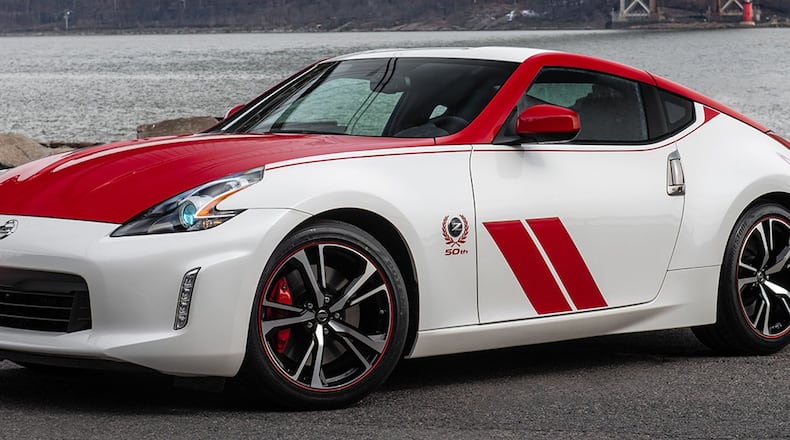The Z came to America after a gestation period in Japan in the ’60s. The TT blossomed in 1998 at the Paris auto show after making the rounds as a raved-about concept study. In late maturity now, both cars have, essentially, bottomed out.
Most dealers may carry one trim level of the TT or the Z (its Nissan-branded offspring); many dealers won’t stock the cars at all.
“If you want a Z, you’ll have to order it,” one dealer on Long Island said. “And leave a nonrefundable deposit.”
In the car industry, when sales flag this much, extinction is imminent. Indeed, there have been rumors that, sooner rather than later, both cars will be killed outright or “reinvented,” possibly as electrics, by their corporate parents – the Volkswagen group and the Renault-Nissan alliance.
The post-mortems, doubtless, will be full throated and numerous.
But, to put a reverse spin on Mark Antony’s well-worn eulogy of Caesar, we come here not to bury the Z and the TT but to praise them.
“For Audi, the TT was to be sort of a club car,” said the car’s designer, Walter de Silva. The plan, he added, was “to generate a model that was unique for the brand, and all new.”
De Silva, now 68 and living in Munich, was appointed head of Audi design in 2002. From 2007 to 2015, he essentially supervised the design strategy for the entire Volkswagen group, including the TT, the Scirocco, the Passat and the Golf. Today he designs his own line of – wait for it – women’s shoes.
Although de Silva considers the 2007 Audi A5 coupe the pinnacle of his automotive design art (“the sex appeal, the shape of the lights, the architecture”), he also boasts about his so-called Singleframe front-end graphics for the TT that migrated across the range.
The bold, upright, trapezoidal elements of the grille “created a brand identity,” de Silva said. Through the decades it has evolved as the symbol and signature of Audi; on the 20th Anniversary TT, the black grille rather starkly sets off the pearly Aviator Gray paint.
“The first-generation TT was an extreme experiment, to raise the sportiness of the Audi brand,” said Dany Garand, an Audi designer in Ingolstadt, Germany, where the company is based.
In fact, TT stands for the Tourist Trophy, the demanding motorcycle race held each year on the Isle of Man in the Irish Sea.
“It was very far from the mainstream of what Audi was doing at the time: clean, Bauhaus, with a touch of emotion,” Garand said.
The original TT was sculpted as well with input from the designers Freeman Thomas and Peter Schreyer, who is now at Kia. Garand considers it as an exercise in spheres, “very geometric: The roof is round. All the corners are spherical.”
“The cabin is one-third the proportion and the body two-thirds,” he added. “This had a very strong influence on the whole lineup of Audi afterwards.”
Evolving the current third-generation car, which arrived in 2014, “was not an easy job,” Garand said. His expectation for the next version “is something sportier, more radical, yet more true to the original,” he said. “I’m more concerned that we don’t lose the DNA.”
As a piece of rolling sculpture, the TT remains, as de Silva said, a “nice toy.” To mark its 20th birthday, Audi has tweaked the current base model hardtop and roadster with mainly cosmetic niceties, like 19-inch wheels, “trumpet” exhausts that mimic the original, Moccasin Bronze seats that echo the much-loved baseball-glove stitch buckets of Audi TTs past, and two limited colors, Aviator Gray and Nimbus Gray.
The manual transmission, a staple of the original, is gone. The turbocharged four-cylinder motor makes a modest 228 horsepower.
Even with the extra equipment and decorations, the birthday pair are no bargain: The starting prices are $53,895 for the coupe and $57,795 for the roadster – $8,000 and $8,400 more than the non-special models. Of the 990 units produced, American dealers are sharing 80, Audi said.
Some 30 years before the TT emerged into series production, the Datsun 240Z (Datsun was then part of Nissan Motors) loudly announced the intention of the Japanese to build a mass-market sports car. It didn’t hurt that the sleek fastback with the long hood had design echoes of Jaguar’s fabulous E-type, and that the price – about $3,500, comparable with muscle cars like the Ford Mustang and Chevrolet Camaro – was in line with the budgets of younger buyers.
At the car’s introduction in 1969, Nissan’s president, Yutaka Katayama, emphasized that the Z “was designed to please a demanding taste that is strictly American.” The later company chief Carlos Ghosn praised its “European styling, American muscle, Japanese quality and global desirability.”
Rob Sass, an expert is classic-car pedigree (and owner of four Zs through the years), said, “It was a groundbreaking car that gave Japanese cars credibility for the first time in the United States.” (Sass is an occasional contributor to this column.)
A parade of Z cars has marched through showrooms over the decades, from the 240 (actually born as the S30 in Japan) to the 260, the 280ZX, the more exotic 300ZX and, from 2003, the 297-horsepower 350Z.
The 50th anniversary 370Z edition, an example of the sixth generation of the model, emerged in red-and-white racing livery at the New York auto show, and, unlike its ancestor, it’s stuffed with bells, whistles and Bose audio. The colors of the special edition mimic those that decorated the motor sports legend Peter Brock’s BRE 240Z.
Pricing starts at just above $37,000 for the birthday model, and, yes, a six-speed manual is offered.
While Sass suggests that the Z car “may have run its course,” he remains a fan. “Remember that without the Z, there’s probably no RX-7, no Honda S2000, no Toyota MR2,” he said. “It set the future for a whole wave of Japanese sports cars.”
About the Author
